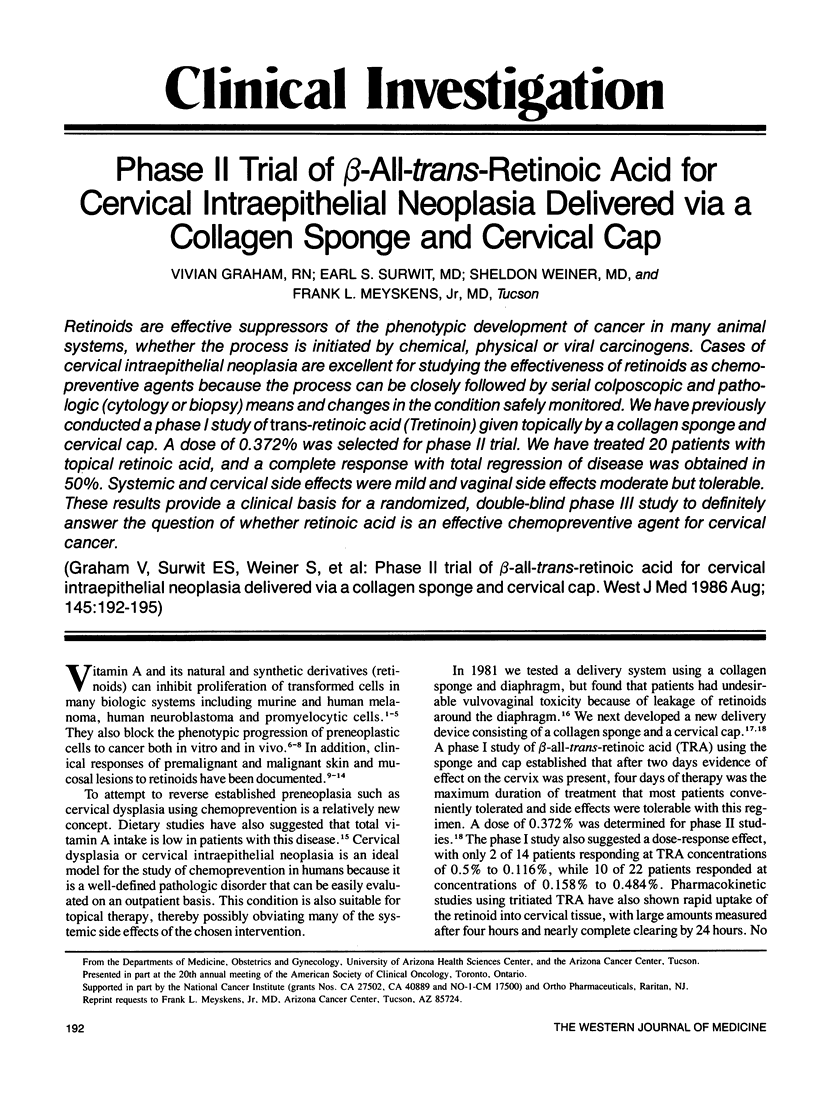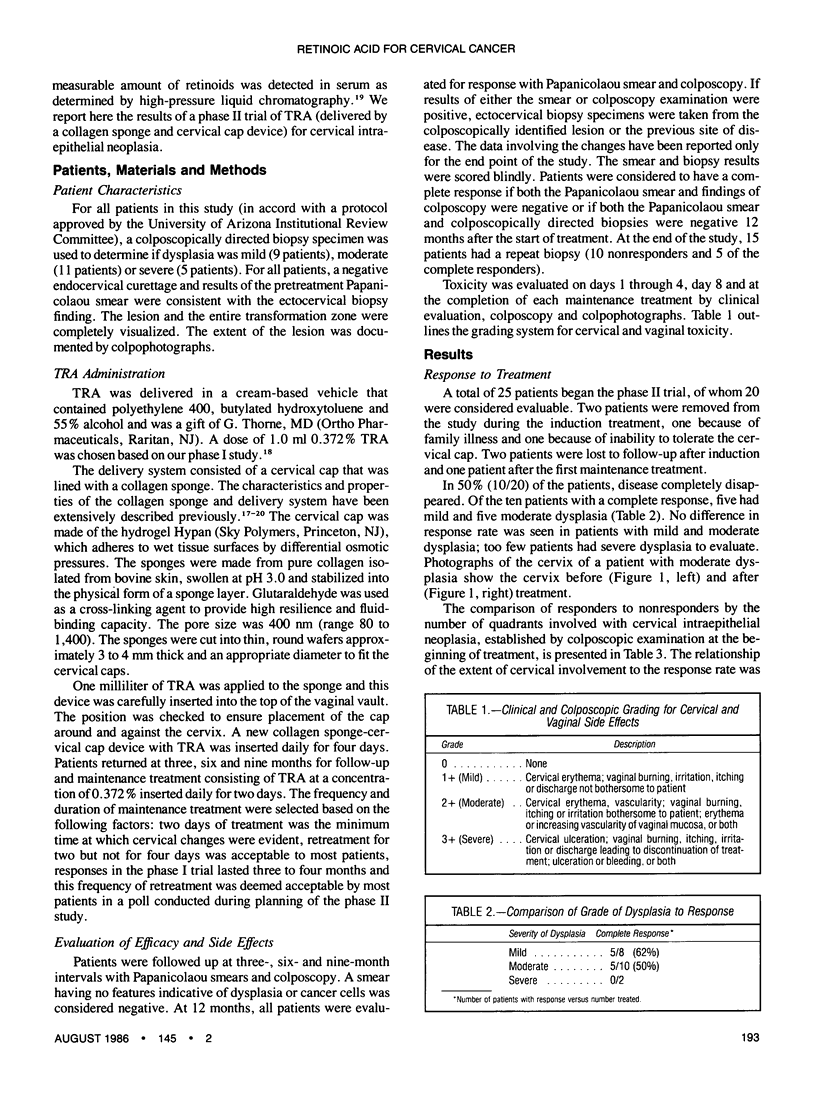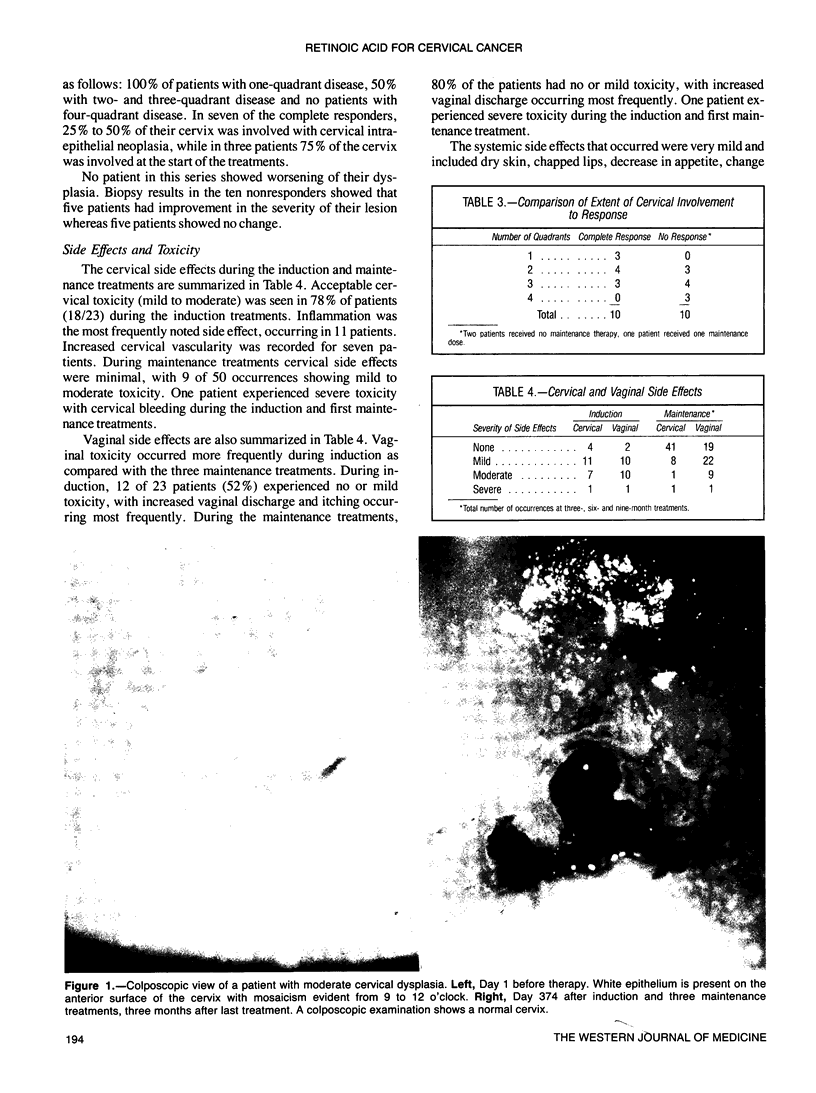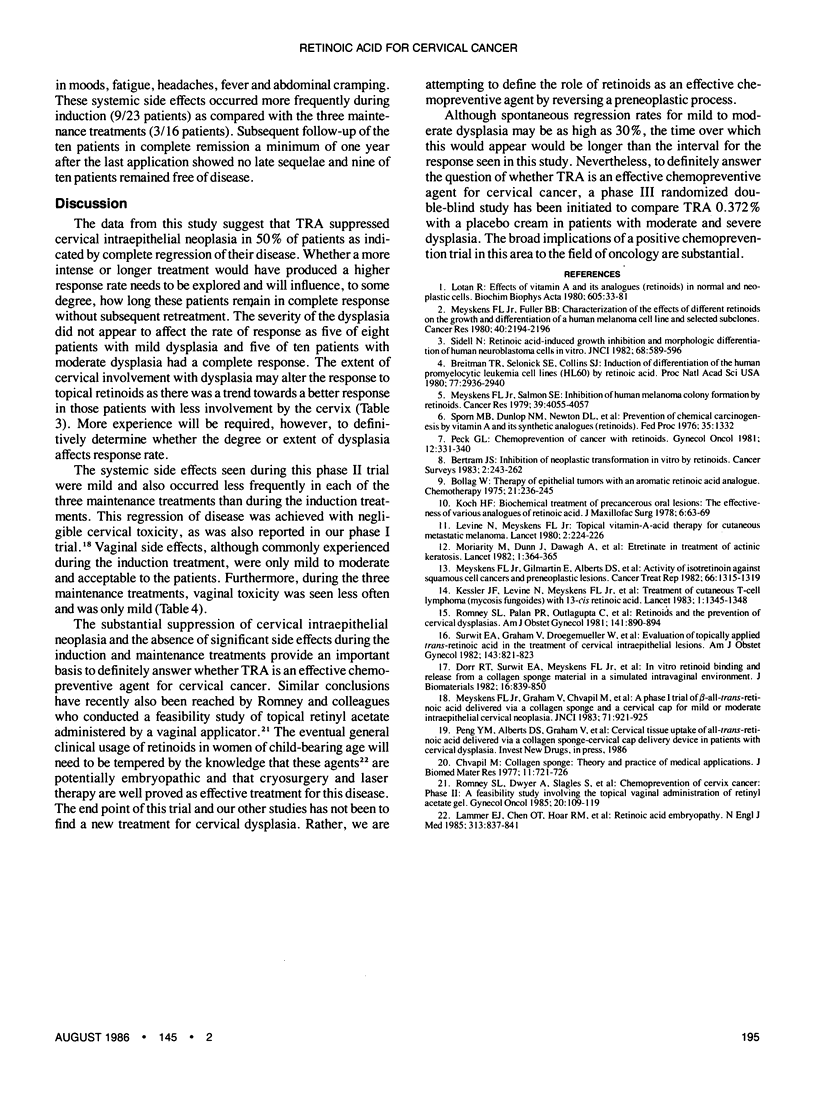Abstract
Retinoids are effective suppressors of the phenotypic development of cancer in many animal systems, whether the process is initiated by chemical, physical or viral carcinogens. Cases of cervical intraepithelial neoplasia are excellent for studying the effectiveness of retinoids as chemopreventive agents because the process can be closely followed by serial colposcopic and pathologic (cytology or biopsy) means and changes in the condition safely monitored. We have previously conducted a phase I study of trans-retinoic acid (Tretinoin) given topically by a collagen sponge and cervical cap. A dose of 0.372% was selected for phase II trial. We have treated 20 patients with topical retinoic acid, and a complete response with total regression of disease was obtained in 50%. Systemic and cervical side effects were mild and vaginal side effects moderate but tolerable. These results provide a clinical basis for a randomized, double-blind phase III study to definitely answer the question of whether retinoic acid is an effective chemopreventive agent for cervical cancer.
Full text
PDF



Images in this article
Selected References
These references are in PubMed. This may not be the complete list of references from this article.
- Bollag W. Therapy of epithelial tumors with an aromatic retinoic acid analog. Chemotherapy. 1975;21(3-4):236–247. doi: 10.1159/000221864. [DOI] [PubMed] [Google Scholar]
- Breitman T. R., Selonick S. E., Collins S. J. Induction of differentiation of the human promyelocytic leukemia cell line (HL-60) by retinoic acid. Proc Natl Acad Sci U S A. 1980 May;77(5):2936–2940. doi: 10.1073/pnas.77.5.2936. [DOI] [PMC free article] [PubMed] [Google Scholar]
- Chvapil M. Collagen sponge: theory and practice of medical applications. J Biomed Mater Res. 1977 Sep;11(5):721–741. doi: 10.1002/jbm.820110508. [DOI] [PubMed] [Google Scholar]
- Dorr R. T., Surwit E. A., Droegemueller W., Alberts D. S., Meyskens F. L., Chvapil M. In vitro retinoid binding and release from a collagen sponge material in a simulated intravaginal environment. J Biomed Mater Res. 1982 Nov;16(6):839–850. doi: 10.1002/jbm.820160609. [DOI] [PubMed] [Google Scholar]
- Kessler J. F., Meyskens F. L., Jr, Levine N., Lynch P. J., Jones S. E. Treatment of cutaneous T-cell lymphoma (mycosis fungoides) with 13-cis-retinoic acid. Lancet. 1983 Jun 18;1(8338):1345–1347. doi: 10.1016/s0140-6736(83)92136-0. [DOI] [PubMed] [Google Scholar]
- Koch H. F. Biochemical treatment of precancerous oral lesions: the effectiveness of various analogues of retinoic acid. J Maxillofac Surg. 1978 Feb;6(1):59–63. doi: 10.1016/s0301-0503(78)80069-1. [DOI] [PubMed] [Google Scholar]
- Lammer E. J., Chen D. T., Hoar R. M., Agnish N. D., Benke P. J., Braun J. T., Curry C. J., Fernhoff P. M., Grix A. W., Jr, Lott I. T. Retinoic acid embryopathy. N Engl J Med. 1985 Oct 3;313(14):837–841. doi: 10.1056/NEJM198510033131401. [DOI] [PubMed] [Google Scholar]
- Levine N., Meyskens F. L. Topical vitamin-A-acid therapy for cutaneous metastatic melanoma. Lancet. 1980 Aug 2;2(8188):224–226. doi: 10.1016/s0140-6736(80)90119-1. [DOI] [PubMed] [Google Scholar]
- Lotan R. Effects of vitamin A and its analogs (retinoids) on normal and neoplastic cells. Biochim Biophys Acta. 1980 Mar 12;605(1):33–91. doi: 10.1016/0304-419x(80)90021-9. [DOI] [PubMed] [Google Scholar]
- Meyskens F. L., Jr, Fuller B. B. Characterization of the effects of different retinoids on the growth and differentiation of a human melanoma cell line and selected subclones. Cancer Res. 1980 Jul;40(7):2194–2196. [PubMed] [Google Scholar]
- Meyskens F. L., Jr, Gilmartin E., Alberts D. S., Levine N. S., Brooks R., Salmon S. E., Surwit E. A. Activity of isotretinoin against squamous cell cancers and preneoplastic lesions. Cancer Treat Rep. 1982 Jun;66(6):1315–1319. [PubMed] [Google Scholar]
- Meyskens F. L., Jr, Graham V., Chvapil M., Dorr R. T., Alberts D. S., Surwit E. A. A phase I trial of beta-all-trans-retinoic acid delivered via a collagen sponge and a cervical cap for mild or moderate intraepithelial cervical neoplasia. J Natl Cancer Inst. 1983 Nov;71(5):921–925. [PubMed] [Google Scholar]
- Meyskens F. L., Jr, Salmon S. E. Inhibition of human melanoma colony formation by retinoids. Cancer Res. 1979 Oct;39(10):4055–4057. [PubMed] [Google Scholar]
- Moriarty M., Dunn J., Darragh A., Lambe R., Brick I. Etretinate in treatment of actinic keratosis. A double-blind crossover study. Lancet. 1982 Feb 13;1(8268):364–365. doi: 10.1016/s0140-6736(82)91393-9. [DOI] [PubMed] [Google Scholar]
- Romney S. L., Dwyer A., Slagle S., Duttagupta C., Palan P. R., Basu J., Calderin S., Kadish A. Chemoprevention of cervix cancer: Phase I-II: A feasibility study involving the topical vaginal administration of retinyl acetate gel. Gynecol Oncol. 1985 Jan;20(1):109–119. doi: 10.1016/0090-8258(85)90131-3. [DOI] [PubMed] [Google Scholar]
- Romney S. L., Palan P. R., Duttagupta C., Wassertheil-Smoller S., Wylie J., Miller G., Slagle N. S., Lucido D. Retinoids and the prevention of cervical dysplasias. Am J Obstet Gynecol. 1981 Dec 15;141(8):890–894. doi: 10.1016/s0002-9378(16)32680-1. [DOI] [PubMed] [Google Scholar]
- Sidell N. Retinoic acid-induced growth inhibition and morphologic differentiation of human neuroblastoma cells in vitro. J Natl Cancer Inst. 1982 Apr;68(4):589–596. [PubMed] [Google Scholar]
- Sporn M. B., Dunlop N. M., Newton D. L., Smith J. M. Prevention of chemical carcinogenesis by vitamin A and its synthetic analogs (retinoids). Fed Proc. 1976 May 1;35(6):1332–1338. [PubMed] [Google Scholar]
- Surwit E. A., Graham V., Droegemueller W., Alberts D., Chvapil M., Dorr R. T., Davis J. R., Meyskens F. L., Jr Evaluation of topically applied trans-retinoic acid in the treatment of cervical intraepithelial lesions. Am J Obstet Gynecol. 1982 Aug 1;143(7):821–823. doi: 10.1016/0002-9378(82)90016-3. [DOI] [PubMed] [Google Scholar]



